A Functional Zoning Method in Rural Landscape Based on High-Resolution Satellite Imagery
Abstract
:1. Introduction
2. Materials and Methods
2.1. Study Area and Datasets
2.2. Methodology
2.3. Landscape Contextual Features
2.3.1. Landscape Classification
2.3.2. Landscape Contextual Features
2.4. Landscape Characteries
2.4.1. Landscape Units
2.4.2. Landscape Heterogeneity Indices
2.5. Automatic Definition of Boundaries
2.6. Evaluation of Mapping Quality (Reference Functional Zone Boundary)
3. Result
3.1. Results of the Experimental Validation in Case A
3.1.1. Metrics of Landscape Characteristics
3.1.2. Impact of the Pre-Defined Parameters of Pattern Heterogeneity
3.1.3. Impact of the Pre-Defined Parameters of Shape Heterogeneity
3.1.4. The Final Rural Landscape Functional Zones
3.2. Application of Different Rural Pattern Types
- For Case B, = 0.0746 (80th percentile of ), and = 0.0009 (25th percentile of ).
- For Case C, = 0.0596 (90th percentile of ), and = 0.0284 (23rd percentile of ).
4. Discussion
4.1. Ability to Quantify Landscape Characteristics
4.2. A Multiscale Merging of Units to Obtain Functional Zones
4.3. Applicability to Functional Zoning in Villages with Different Landscape Patterns
4.4. Limitation
5. Conclusions
6. Patents
Author Contributions
Funding
Data Availability Statement
Acknowledgments
Conflicts of Interest
References
- Liu, H.; Jiang, G.; Zhuang, H.; Wang, K. Distribution, utilization structure and potential of biomass resources in rural China: With special references of crop residues. Renew. Sustain. Energy Rev. 2008, 12, 1402–1418. [Google Scholar] [CrossRef]
- Zhang, L.; Luo, Z.; Mallon, D.; Li, C.; Jiang, Z. Biodiversity conservation status in China’s growing protected areas. Biol. Conserv. 2017, 210, 89–100. [Google Scholar] [CrossRef]
- Picuno, P.; Cillis, G.; Statuto, D. Investigating the time evolution of a rural landscape: How historical maps may provide environmental information when processed using a GIS. Ecol. Eng. 2019, 139, 105580. [Google Scholar] [CrossRef]
- Yang, Y.; Bao, W.; Liu, Y. Coupling coordination analysis of rural production-living-ecological space in the Beijing-Tianjin-Hebei region. Ecol. Indic. 2020, 117, 106512. [Google Scholar] [CrossRef]
- Wang, C.; Tang, N. Spatiotemporal characteristics and evolution of rural production living- ecological space function coupling coordination in Chongqing Municipality. Geogr. Res. 2018, 37, 1100–1114. [Google Scholar]
- Tan, X.L.; An, Y.; Su, Y.; Zhou, G.; He, Y. Spatio-temporal Dynamics of Agricultural Function in Changsha-Zhuzhou-Xiangtan Urban Agglomerations. Sci. Geogr. Sin. 2018, 38, 708–716. [Google Scholar]
- He, B.-J.; Ding, L.; Prasad, D. Enhancing urban ventilation performance through the development of precinct ventilation zones: A case study based on the Greater Sydney, Australia. Sustain. Cities Soc. 2019, 47, 101472. [Google Scholar] [CrossRef]
- Liu, H.; He, B.-J.; Gao, S.; Zhan, Q.; Yang, C. Influence of non-urban reference delineation on trend estimate of surface urban heat island intensity: A comparison of seven methods. Remote. Sens. Environ. 2023, 296, 113735. [Google Scholar] [CrossRef]
- Locke, C.M.; Rissman, A.R. Factors influencing zoning ordinance adoption in rural and exurban townships. Landsc. Urban Plan. 2015, 134, 167–176. [Google Scholar] [CrossRef]
- Liu, Y.; Fu, B.; Zhao, W.; Wang, S.; Deng, Y. A solution to the conflicts of multiple planning boundaries: Landscape functional zoning in a resource-based city in China. Habitat Int. 2018, 77, 43–55. [Google Scholar] [CrossRef]
- Fan, J. Draft of major function oriented zoning of China. Acta Geogr. Sin. 2015, 70, 186–201. [Google Scholar]
- Nie, W.; Yang, F.; Xu, B.; Bao, Z.; Shi, Y.; Liu, B.; Wu, R.; Lin, W. Spatiotemporal Evolution of Landscape Patterns and Their Driving Forces Under Optimal Granularity and the Extent at the County and the Environmental Functional Regional Scales. Front. Ecol. Evol. 2022, 10, 954232. [Google Scholar] [CrossRef]
- Liu, Y.; Li, T.; Zhao, W.; Wang, S.; Fu, B. Landscape functional zoning at a county level based on ecosystem services bundle: Methods comparison and management indication. J. Environ. Manag. 2019, 249, 109315. [Google Scholar] [CrossRef]
- Zhang, B.; Zhong, C.; Gao, Q.; Shabrina, Z.; Tu, W. Delineating urban functional zones using mobile phone data: A case study of cross-boundary integration in Shenzhen-Dongguan-Huizhou area. Comput. Environ. Urban Syst. 2022, 98, 101872. [Google Scholar] [CrossRef]
- Newbold, T.; Hudson, L.N.; Hill, S.L.L.; Contu, S.; Lysenko, I.; Senior, R.A.; Börger, L.; Bennett, D.J.; Choimes, A.; Collen, B.; et al. Global effects of land use on local terrestrial biodiversity. Nature 2015, 520, 45. [Google Scholar] [CrossRef] [PubMed]
- Song, X.P.; Hansen, M.C.; Stehman, S.V.; Potapov, P.V.; Tyukavina, A.; Vermote, E.F.; Townshend, J.R. Global land change from 1982 to 2016. Nature 2018, 560, 639–643. [Google Scholar] [CrossRef]
- Usman, M.; Liedl, R.; Shahid, M.A.; Abbas, A. Land use/land cover classification and its change detection using multi-temporal MODIS NDVI data. J. Geogr. Sci. 2015, 25, 1479–1506. [Google Scholar] [CrossRef]
- Toure, S.I.; Stow, D.A.; Shih, H.-C.; Weeks, J.; Lopez-Carr, D. Land cover and land use change analysis using multi-spatial resolution data and object-based image analysis. Remote. Sens. Environ. 2018, 210, 259–268. [Google Scholar] [CrossRef]
- Tehrany, M.S.; Pradhan, B.; Jebuv, M.N. A comparative assessment between object and pixel-based classification approaches for land use/land cover mapping using SPOT 5 imagery. Geocarto Int. 2014, 29, 351–369. [Google Scholar] [CrossRef]
- Li, J.; Li, W.; Fu, J.; Gao, J.; Yang, L.; He, W. Using low-altitude UAV remote sensing to identify national park functional zoning boundary: A case study in Qianjiangyuan National Park pilot. Biodivers. Sci. 2019, 27, 42–50. [Google Scholar]
- Watmough, G.R.; Palm, C.A.; Sullivan, C. An operational framework for object-based land use classification of heterogeneous rural landscapes. Int. J. Appl. Earth Obs. Geoinf. 2017, 54, 134–144. [Google Scholar] [CrossRef]
- Zheng, X.; Wu, B.; Weston, M.V.; Zhang, J.; Gan, M.; Zhu, J.; Deng, J.; Wang, K.; Teng, L. Rural Settlement Subdivision by Using Landscape Metrics as Spatial Contextual Information. Remote. Sens. 2017, 9, 486. [Google Scholar] [CrossRef]
- Zhu, Y.; Liu, K.; Myint, S.; Du, Z.; Li, Y.; Cao, J.; Liu, L.; Wu, Z. Integration of GF2 Optical, GF3 SAR, and UAV Data for Estimating Aboveground Biomass of China’s Largest Artificially Planted Mangroves. Remote Sens. 2020, 12, 2039. [Google Scholar] [CrossRef]
- Ning, J.; Liu, J.; Kuang, W.; Xu, X.; Zhang, S.; Yan, C.; Li, R.; Wu, S.; Hu, Y.; Du, G.; et al. Spatiotemporal patterns and characteristics of land-use change in China during 2010–2015. J. Geogr. Sci. 2018, 28, 547–562. [Google Scholar] [CrossRef]
- Vadjunec, J.M.; Frazier, A.E.; Kedron, P.; Fagin, T.; Zhao, Y. A Land Systems Science Framework for Bridging Land System Architecture and Landscape Ecology: A Case Study from the Southern High Plains. Land 2018, 7, 27. [Google Scholar] [CrossRef]
- Kumar, D.; Shekhar, S. Statistical analysis of land surface temperature–vegetation indexes relationship through thermal remote sensing. Ecotoxicol. Environ. Saf. 2015, 121, 39–44. [Google Scholar] [CrossRef]
- Aslan, N.; Koc-San, D. The Use of Land Cover Indices for Rapid Surface Urban Heat Island Detection from Multi-Temporal Landsat Imageries. ISPRS Int. J. Geoinf. 2021, 10, 416. [Google Scholar] [CrossRef]
- Viana, C.M.; Girão, I.; Rocha, J. Long-Term Satellite Image Time-Series for Land Use/Land Cover Change Detection Using Refined Open Source Data in a Rural Region. Remote. Sens. 2019, 11, 1104. [Google Scholar] [CrossRef]
- Talukdar, S.; Singha, P.; Mahato, S.; Shahfahad; Pal, S.; Liou, Y.-A.; Rahman, A. Land-Use Land-Cover Classification by Machine Learning Classifiers for Satellite Observations—A Review. Remote. Sens. 2020, 12, 1135. [Google Scholar] [CrossRef]
- Radoux, J.; Defourny, P. A quantitative assessment of boundaries in automated forest stand delineation using very high resolution imagery. Remote. Sens. Environ. 2007, 110, 468–475. [Google Scholar] [CrossRef]
- Garcia-Pedrero, A.; Lillo-Saavedra, M.; Rodriguez-Esparragon, D.; Gonzalo-Martin, C. Deep Learning for Automatic Outlining Agricultural Parcels: Exploiting the Land Parcel Identification System. IEEE Access 2019, 7, 158223–158236. [Google Scholar] [CrossRef]
- Weidong, M.; Chunjing, L.; Zongming, W.; Mingming, J.; Dehua, M.; Mingyue, L.; Chunyan, L. Study on Dynamic of Wetlands Landscape in the Trans-boundary Regions between China and Russia of Ussuri River Watershed based on Object-oriented Classification Method. Remote Sens. Technol. Appl. 2016, 31, 378–387. [Google Scholar]
- Blaschke, T.; Hay, G.J.; Kelly, M.; Lang, S.; Hofmann, P.; Addink, E.; Feitosa, R.Q.; van der Meer, F.; van der Werff, H.; van Coillie, F.; et al. Geographic Object-Based Image Analysis—Towards a new paradigm. ISPRS J. Photogramm. Remote Sens. 2014, 87, 180–191. [Google Scholar] [CrossRef] [PubMed]
- Fernandes, M.R.; Aguiar, F.C.; Silva, J.M.; Ferreira, M.T.; Pereira, J.M. Optimal attributes for the object based detection of giant reed in riparian habitats: A comparative study between Airborne High Spatial Resolution and WorldView-2 imagery. Int. J. Appl. Earth Obs. Geoinf. 2014, 32, 79–91. [Google Scholar] [CrossRef]
- Wu, B.; Yu, B.; Shu, S.; Wu, Q.; Zhao, Y.; Wu, J. A spatiotemporal structural graph for characterizing land cover changes. Int. J. Geogr. Inf. Sci. 2021, 35, 397–425. [Google Scholar] [CrossRef]
- Aksoy, S.; Akcay, H.G.; Wassenaar, T. Automatic Mapping of Linear Woody Vegetation Features in Agricultural Landscapes Using Very High Resolution Imagery. IEEE Trans. Geosci. Remote. Sens. 2010, 48, 511–522. [Google Scholar] [CrossRef]
- Du, J.; Watts, J.D.; Jiang, L.; Lu, H.; Cheng, X.; Duguay, C.; Farina, M.; Qiu, Y.; Kim, Y.; Kimball, J.S.; et al. Context-Enabled Extraction of Large-Scale Urban Functional Zones from Very-High-Resolution Images: A Multiscale Segmentation Approach. Remote Sens. 2019, 11, 1952. [Google Scholar] [CrossRef]
- Li, C.; Liang, S.; Che, Q. Spatial Reconstruction of the Rural Settlements in Wuhu City Based on the Function Oriented Zoning. Resour. Environ. Yangtze Basin 2015, 24, 1736–1743. [Google Scholar]
- Moos, A.I.; Dear, M.J. Structuration Theory in Urban Analysis 1. Theoretical Exegesis. Environ. Plan. A 1986, 18, 231–252. [Google Scholar] [CrossRef]
- Zhang, X.; Du, S.; Wang, Q. Hierarchical semantic cognition for urban functional zones with VHR satellite images and POI data. ISPRS J. Photogramm. Remote. Sens. 2017, 132, 170–184. [Google Scholar] [CrossRef]
- Yohannes, H.; Soromessa, T.; Argaw, M.; Dewan, A. Changes in landscape composition and configuration in the Beressa watershed, Blue Nile basin of Ethiopian Highlands: Historical and future exploration. Heliyon 2020, 6, e04859. [Google Scholar] [CrossRef]
- Du, S.H.; Du, S.; Liu, B.; Zhang, X. Mapping large-scale and fine-grained urban functional zones from VHR images using a multi-scale semantic segmentation network and object based approach. Remote Sens. Environ. 2021, 261, 12480. [Google Scholar] [CrossRef]
- Fahrig, L.; Baudry, J.; Brotons, L.; Burel, F.G.; Crist, T.O.; Fuller, R.J.; Sirami, C.; Siriwardena, G.M.; Martin, J.-L. Functional landscape heterogeneity and animal biodiversity in agricultural landscapes. Ecol. Lett. 2011, 14, 101–112. [Google Scholar] [CrossRef]
- Xiao, J.; Watanabe, T.; Lu, X.; Chand, M.B.; Umarhadi, D.A.; Chen, X.; Avtar, R. Integrating land use/land cover change with change in functional zones’ boundary of the East Dongting Lake National Nature Reserve, China. Phys. Chem. Earth 2022, 126, 103041. [Google Scholar] [CrossRef]
- Nielsen, M.M.; Ahlqvist, O. Classification of different urban categories corresponding to the strategic spatial level of urban planning and management using a SPOT4 scene. J. Spat. Sci. 2015, 60, 99–117. [Google Scholar] [CrossRef]
- Du, S.H.; Du, S.; Liu, B.; Zhang, X.; Zheng, Z. Large-scale urban functional zone mapping by integrating remote sensing images and open social data. Giscience Remote Sens. 2020, 57, 411–430. [Google Scholar] [CrossRef]
- Zheng, Z.; Du, S.; Du, S.; Zhang, X. A multiscale approach to delineate dune-field landscape patches. Remote. Sens. Environ. 2020, 237, 111591. [Google Scholar] [CrossRef]
- Stewart, I.D.; Oke, T.R. Local Climate Zones for Urban Temperature Studies. Bull. Am. Meteorol. Soc. 2012, 93, 1879–1900. [Google Scholar] [CrossRef]
- Willemen, L.; Liu, Y.; Lü, Y.-H.; Feng, X.-M. Landscape pattern analysis in landscape ecology: Current, challenges and future. Acta Ecol. Sin. 2008, 28, 5521–5531. [Google Scholar]
- Verburg, P.H.; Hein, L.; van Mensvoort, M.E. Spatial characterization of landscape functions. Landsc. Urban Plan. 2008, 88, 34–43. [Google Scholar] [CrossRef]
- Nielsen, M.M. Remote sensing for urban planning and management: The use of window-independent context segmentation to extract urban features in Stockholm. Comput. Environ. Urban Syst. 2015, 52, 1–9. [Google Scholar] [CrossRef]
- Chen, W.; Xiao, D.; Li, X. The Characteristics and Contents of Landscape Spatial Analysis. Acta Ecol. Sin. 2002, 22, 1135–1142. [Google Scholar]
- Hay, G.J.; Castilla, G.; Wulder, M.A.; Ruiz, J.R. An automated object-based approach for the multiscale image segmentation of forest scenes. Int. J. Appl. Earth Obs. Geoinf. 2005, 7, 339–359. [Google Scholar] [CrossRef]
- Drăguţ, L.; Csillik, O.; Eisank, C.; Tiede, D. Automated parameterisation for multi-scale image segmentation on multiple layers. ISPRS J. Photogramm. Remote Sens. 2014, 88, 119–127. [Google Scholar] [CrossRef]
- Chao, W.; Ai, G.; Du, L.; Yan, L. Analysis of Landscape Ecological Effects before and after the Land Consolidation Take Land Consolidation Project in Liuxuanyao Villige in Zezhou County in Shanxi Province. J. Shanxi Agric. Sci. 2010, 38, 49–52. [Google Scholar]
- Yao, W.; Zhang, Y.; Zhu, Q. Effects of woodland spatial distribution on soil erosion in small watershed: A case study in Wuqi County, Northern Shaanxi. Sci. Soil Water Conserv. 2015, 13, 16–22. [Google Scholar]
- Jellema, A.; Stobbelaar, D.-J.; Groot, J.C.; Rossing, W.A. Landscape character assessment using region growing techniques in geographical information systems. J. Environ. Manag. 2009, 90, S161–S174. [Google Scholar] [CrossRef]
- Zhang, H.; Wang, Y.; Shang, J.; Liu, M.; Li, Q. Investigating the impact of classification features and classifiers on crop mapping performance in heterogeneous agricultural landscapes. Int. J. Appl. Earth Obs. Geoinf. 2021, 102, 102388. [Google Scholar] [CrossRef]
- Zhang, X.; Du, S.; Wang, Q.; Zhou, W. Multiscale Geoscene Segmentation for Extracting Urban Functional Zones from VHR Satellite Images. Remote. Sens. 2018, 10, 281. [Google Scholar] [CrossRef]
- Liu, L.; Li, Z.; Zhang, H. Discussion on characteristics of Chinese rural landscape and its planning objectives and contents. Ecol. Environ. 2004, 13, 445–448. [Google Scholar]
- Liu, Y.; Zhou, Y.; Li, Y. Rural regional system and rural revitalization strategy in China. Acta Geogr. Sin. 2019, 74, 2511–2528. [Google Scholar]

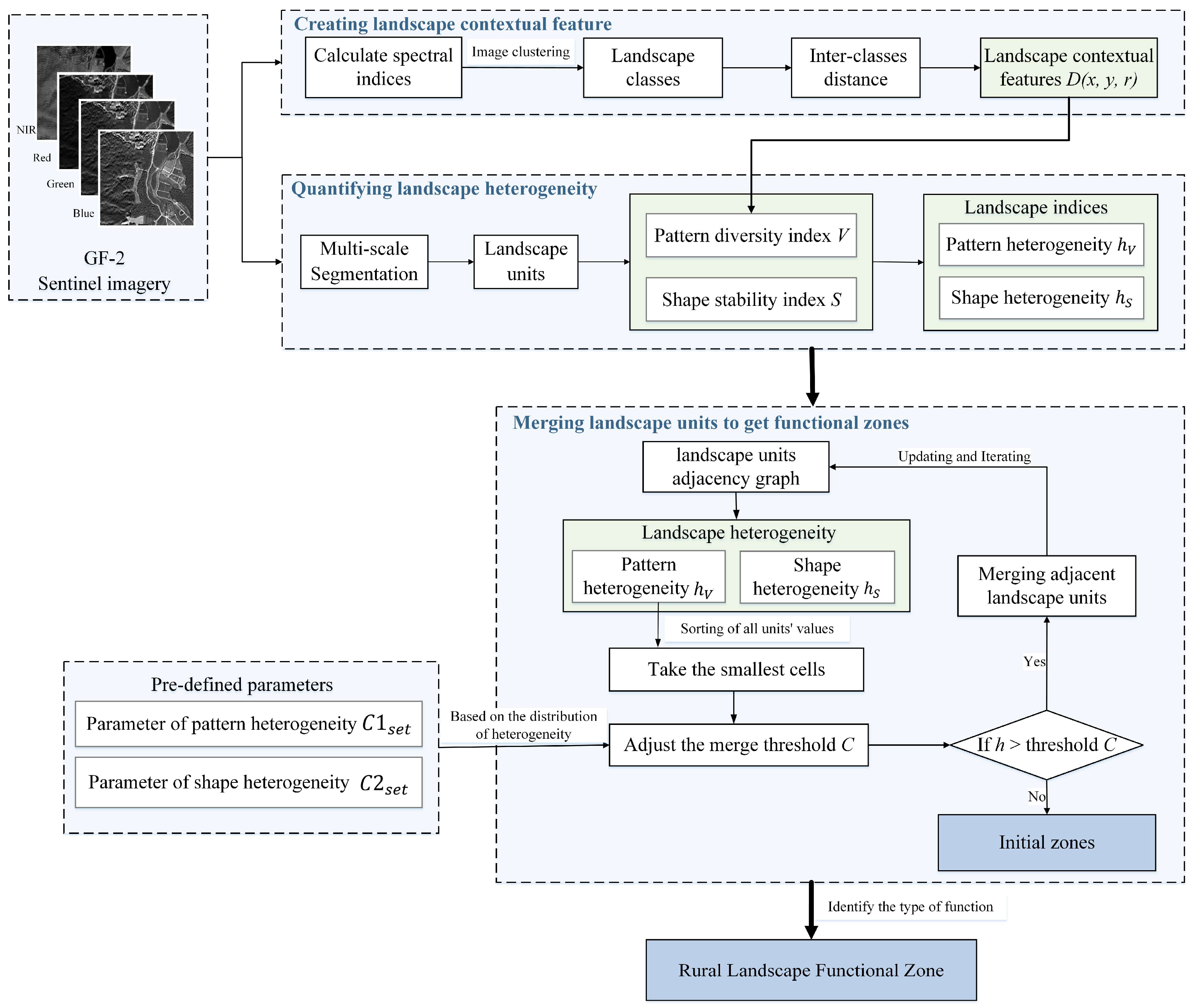
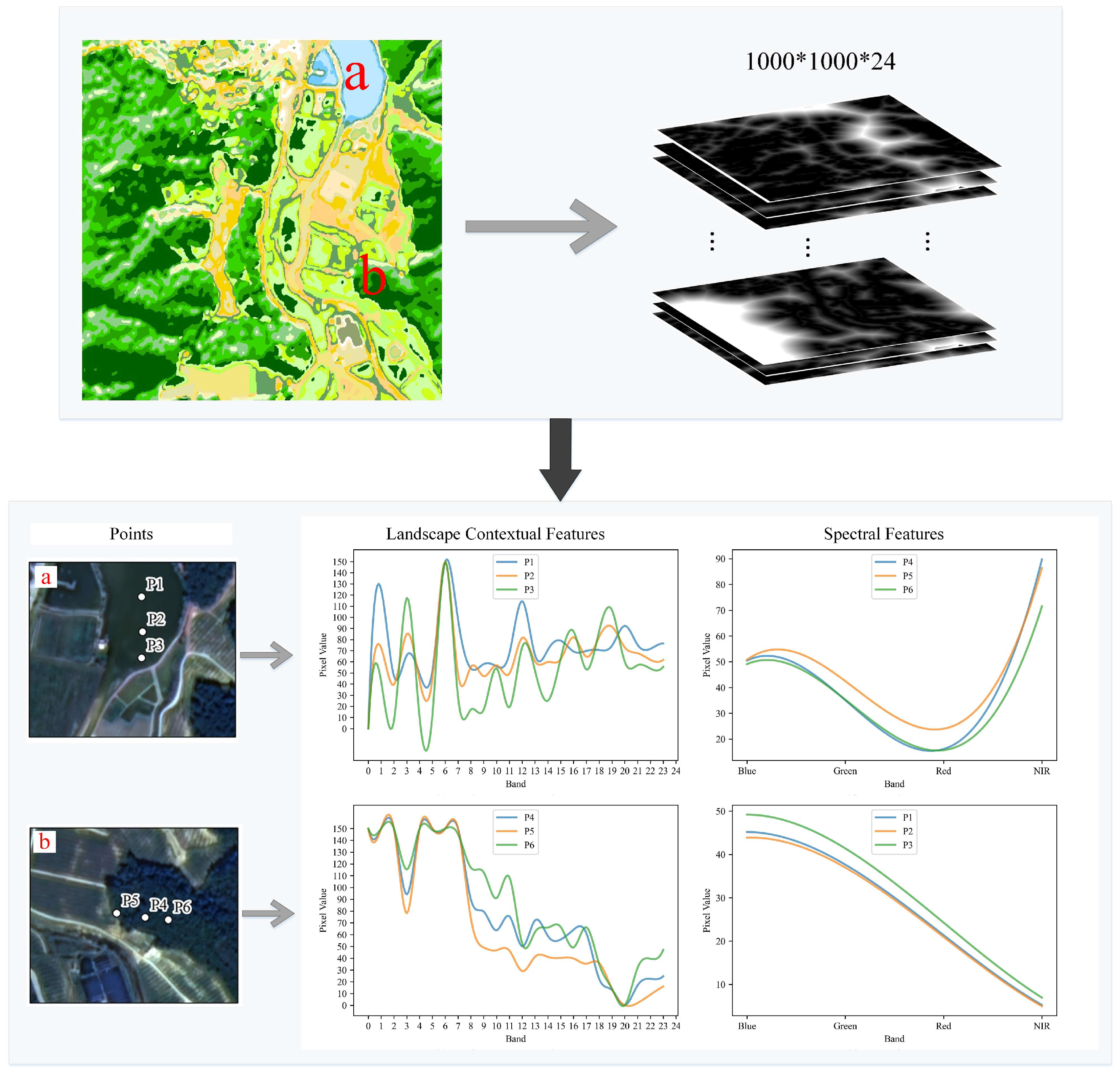


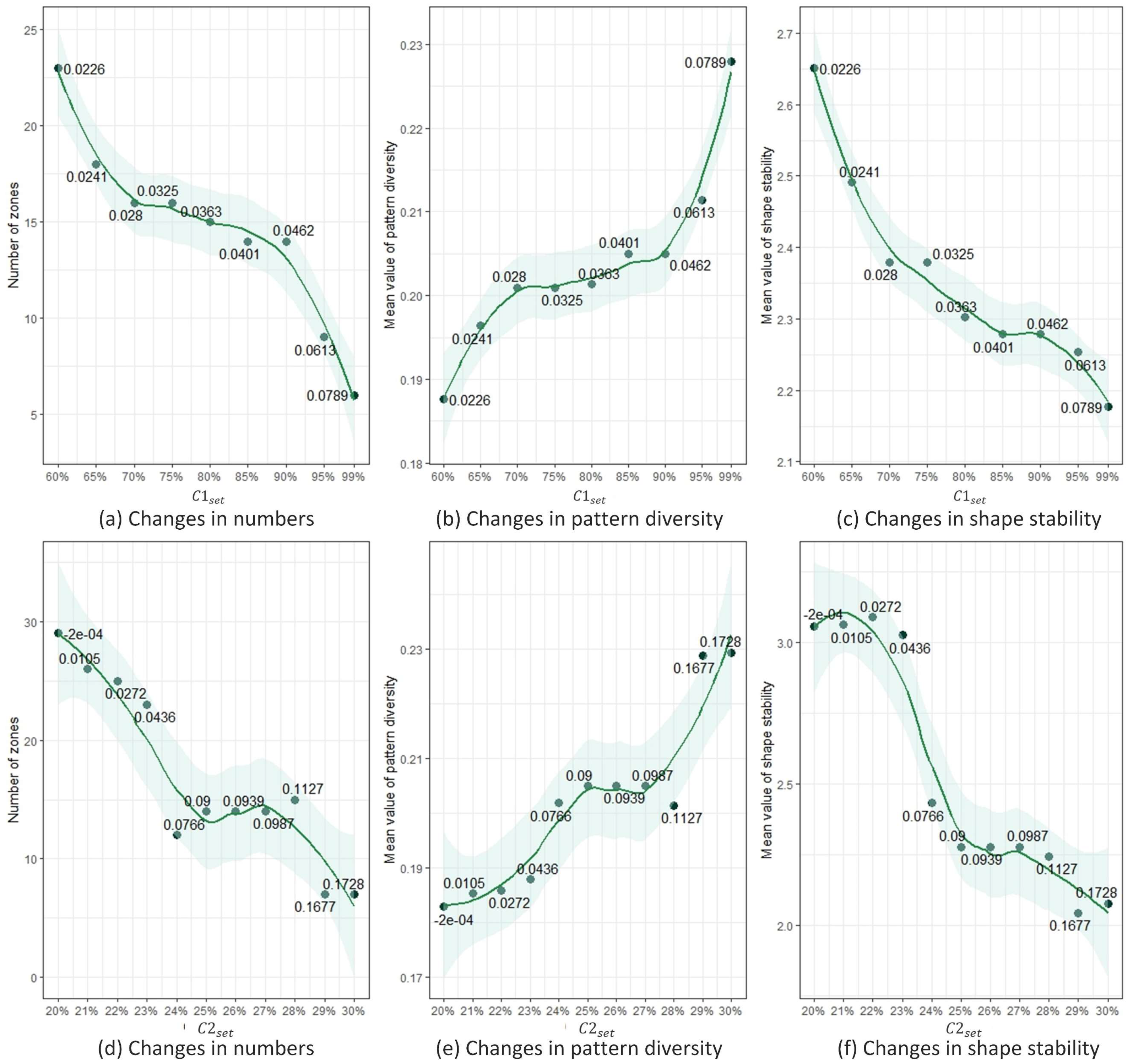


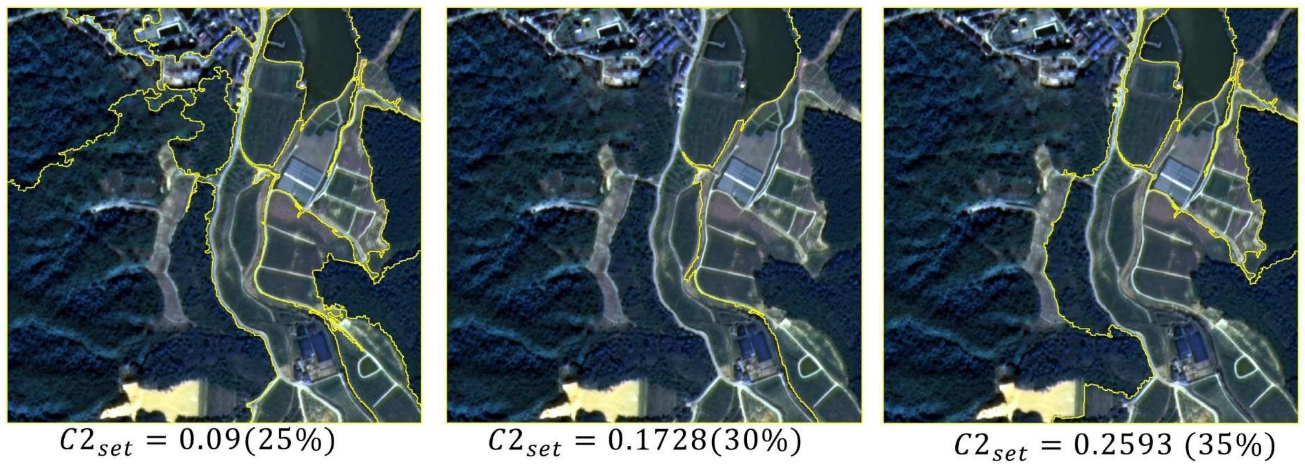

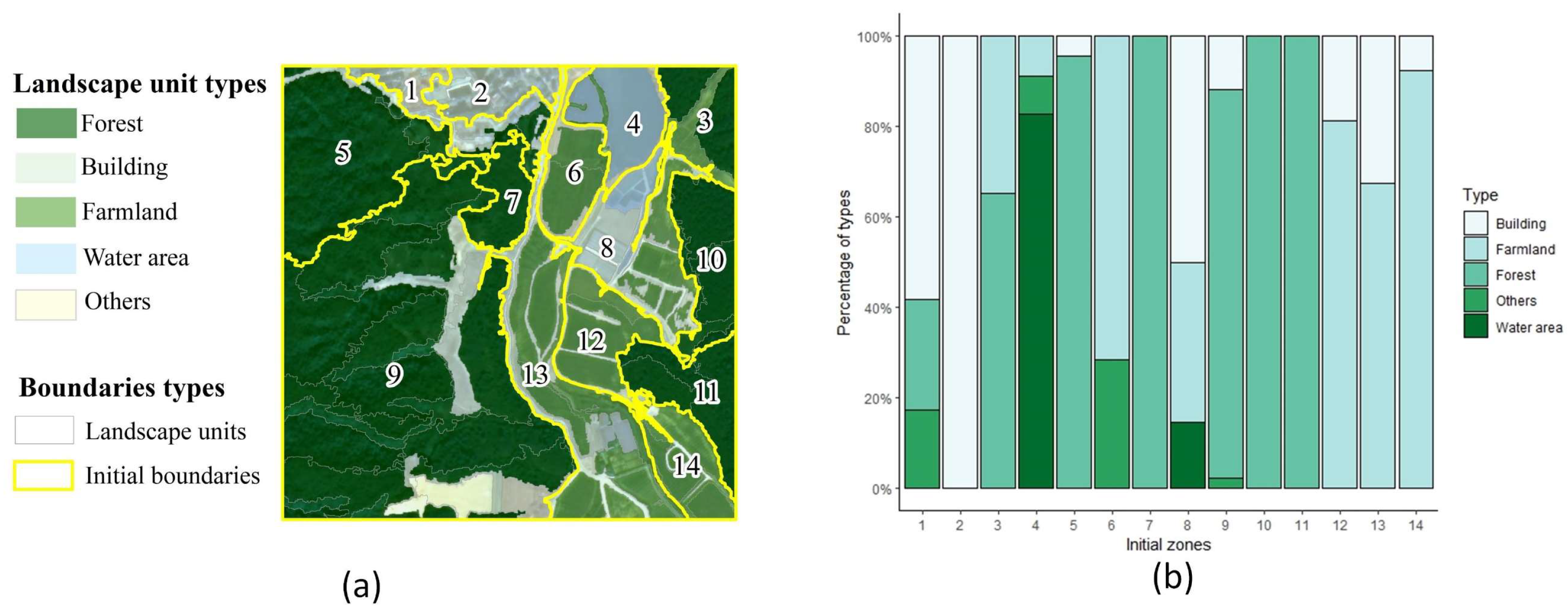
| Case | Location Province | Patterns | Main Landscape Cover Types |
|---|---|---|---|
| Case A | Fujian | Hilly countryside | Open low-rise, dense trees, low plants, water |
| Case B | Xinjiang | Flat countryside | Large low-rise, dense trees, low plants |
| Case C | Inner Mongolia Autonomous Region | Grassland countryside | Sparsely built, dense trees, low plants, water |
| Index | Index Full Name | Equations |
|---|---|---|
| NDVI | Normalized Difference Vegetation Index | |
| SAVI | Soil-Adjusted Vegetation Index | |
| NDWI | Normalized Difference Water Index |
| Evaluation Metrics | Equations | Explanations |
|---|---|---|
| Matching ratio (MR) | A bigger value signifies a better match. | |
| Inclusion ratio (IR) | A value of one indicates the whole mapping zone is within the reference zone, and a bigger value indicates a better match. | |
| Recall accuracy of each functional zone type (TRA) | Represents the proportion of accurately mapped area that aligns with the reference functional zone type. | |
| Precision accuracy of each functional zone type (TPA) | Measures the accuracy of defining the actual functional zone type, represented as a percentage of correctly classified area. | |
| Overall accuracy (OA) | Indicates the overall accuracy of mapping functional zones with different functions. |
| Case A | MR (%) | IR (%) | Case B | MR (%) | IR (%) | Case C | MR (%) | IR (%) |
|---|---|---|---|---|---|---|---|---|
| Initial zones | 39.9 | 94.0 | Initial zones | 28.1 | 81.1 | Initial zones | 27.5 | 83.8 |
| Final zones | 93.1 | 78.5 | Final zones | 81.1 | 80.7 | Final zones | 89.2 | 85.5 |
| Case A | OA: 95.9% | Forest | Farmland | Building | Irrigation | |
| TRA (%) | 96.7 | 95.1 | 94.7 | 92.0 | ||
| TPA (%) | 98.00 | 95.5 | 83.3 | 89.4 | ||
| Case B | OA: 89.0% | Forest | Farmland | Building | ||
| TRA (%) | 99.1 | 67.0 | 65.4 | |||
| TPA (%) | 87.1 | 95.8 | 94.1 | |||
| Case C | OA: 92.1% | Forest | Farmland | Building | Grassland | Watershed |
| TRA (%) | 98.6 | 91.4 | 86.9 | 67.3 | 89.5 | |
| TPA (%) | 93.0 | 91.3 | 96.4 | 90.9 | 79.0 |
Disclaimer/Publisher’s Note: The statements, opinions and data contained in all publications are solely those of the individual author(s) and contributor(s) and not of MDPI and/or the editor(s). MDPI and/or the editor(s) disclaim responsibility for any injury to people or property resulting from any ideas, methods, instructions or products referred to in the content. |
© 2023 by the authors. Licensee MDPI, Basel, Switzerland. This article is an open access article distributed under the terms and conditions of the Creative Commons Attribution (CC BY) license (https://creativecommons.org/licenses/by/4.0/).
Share and Cite
Zheng, Y.; Dian, Y.; Guo, Z.; Yao, C.; Wu, X. A Functional Zoning Method in Rural Landscape Based on High-Resolution Satellite Imagery. Remote Sens. 2023, 15, 4920. https://doi.org/10.3390/rs15204920
Zheng Y, Dian Y, Guo Z, Yao C, Wu X. A Functional Zoning Method in Rural Landscape Based on High-Resolution Satellite Imagery. Remote Sensing. 2023; 15(20):4920. https://doi.org/10.3390/rs15204920
Chicago/Turabian StyleZheng, Yuying, Yuanyong Dian, Zhiqiang Guo, Chonghuai Yao, and Xuefei Wu. 2023. "A Functional Zoning Method in Rural Landscape Based on High-Resolution Satellite Imagery" Remote Sensing 15, no. 20: 4920. https://doi.org/10.3390/rs15204920






